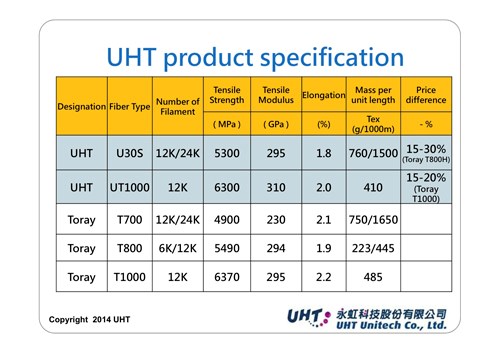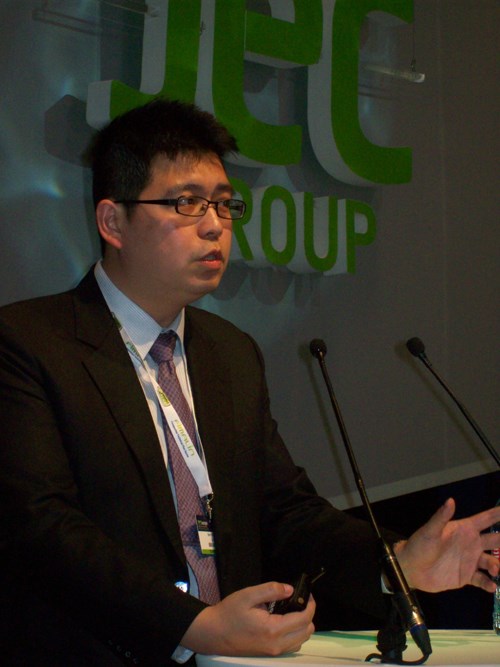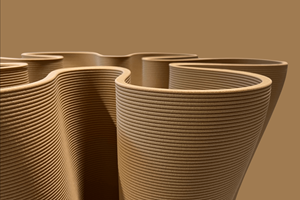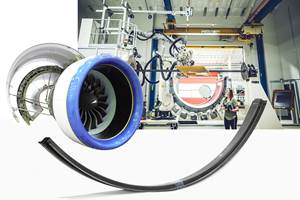UHT Unitech touts microwave graphitization process for carbon fiber
In an unusual departure from the norm, Taiwan-based UHT Unitech is graphitizing 3K to 48K T700-grade carbon fiber to make T800- and T1000-grade carbon fiber.

Materials data for UHT Unitech's carbon fiber.
The carbon fiber market, once the relatively unchanging — not to mention unassailable — preserve of a small, elite group of fiber manufacturers, is in the midst of a massive sea change. The advent of the Boeing 787, Airbus A350 XWB and other commercial aircraft with composite airframes forced Japan's Toray, Teijin and Mitsubishi Rayon (all based in Tokyo) and U.S.-based Hexcel (Stamford, Conn., USA) and Cytec Industries (Woodland Park, N.J., USA) to commit to capacity increases that, previously, had been viewed as patently insupportable because of the enormous capital investment. Zoltek (St. Louis, Mo., USA) — at long last — and DowAksa (Instanbul, Turkey) joined the club, with commercial-grade fiber, aimed at wind and transportation markets — especially, hoped-for automotive applications.
When the realization of the vertically integrated SGL/BMW carbon fiber supply chain for its i3 and i8 electric cars silenced many doubters, the stage seemed set: SGL's commisioning of its carbon fiber plant in Moses Lake, Wash., USA, stimulated a round of partnership announcements between fiber producers, auto OEMs and others interested in repeating the carbon fiber aerocomposites windfall in the world of autocomposites (see, for example, "Ford, Dow join forces to research carbon composites for production autos"). And a flurry of announcements by new carbon fiber sources: Saudi Basic Industries Corp. (SABIC, Riyadh, Saudi Arabia), Hyosung (Gyeonggi-do, Korea), Alabuga Fiber LLC (Tartarstan, Russia), to mention a few. The once exclusive club has become a larger and more competitive fraternity.
Given all that, the rumor of yet another new PAN-based carbon fiber manufacturer wasn't high on CW's "must see" at this year's JEC Europe event in Paris. In fact, the rumor proved untrue. But CW found that the subject of the rumor, carbon fiber converter UHT Unitech Co. Ltd. (Zhongli, Taiwan), proved unexpectedly intriguing.
Established in 2011, UHT Unitech offers not a new fiber but a graphitization service for composites fabricators who purchase T700-grade PAN-carbon fiber from existing manufacturers. Unitech’s president, Ben Wang, gave a presentation at JEC, describing the company’s business model. Briefly, Wang’s process unspools PAN carbon fiber (3K to 48K) purchased from other sources, burns off the factory-applied sizing, then graphitizes it in Unitech’s — and here's the intriguing part — Wang's patented 2000°C/3632°F microwave ovens. Processed fibers are resized (Wang says he specializes in sizings compatible with thermoplastic resins for sporting goods and industrial applications) and re-spooled.
The result? Wang quips that “no one believes it” but he says he can deliver T800- or T1000-grade fiber at 15 to 30 percent lower cost, because his microwave technology reportedly consumes 30 percent less energy and processes fiber 50 percent faster than conventional graphitization ovens. Further, he claims his process generates no water or air pollution. But most compelling, he claims that test results conducted by the Taichung, Taiwan, branch of independent testing organization SGS SA (Geneva, Switzerland) indicate that his UT30S and UT1000 products are roughly equivalent to the high-end fibers now on the market (see chart). Wang goes farther: Graphitization by conventional means, he says, typically increases the modulus (stiffness) but slightly degrades fiber strength. He claims, however, that his microwave-based process not only increases fiber modulus by 20 to 30 percent but also adds 2 to 5 percent to its strength.
Wang says he’s working with interested parties in the composites manufacturing community, both inside and outside Taiwan. And he says his technical team also works with customers to adopt and adapt UHT Unitech's fiber in their manufacturing processes. Wang offers help, for example, by formulating both prepregs and injection-moldable thermoplastic compounds for use in sporting goods and industrial applications.
Currently capable of producing a total of 300 metric tonnes (roughly 661,380 lb) of fiber per year, UHT Unitech isn't a big threat to the "bigs" in the carbon fiber market. In any case, Wang says he has no intention of threatening anyone: He emphasized that he’s not planning to engage in spinning or carbonization of raw PAN fiber. More importantly, he would he happy to partner with carbon fiber manufacturers who are interested in adopting his less-expensive microwave process for their high-tonnage lines.
It's important to point out, here, that microwave technology is not new to the composites industry. In 2009, no less than GKN Aerospace (Isle of Wight, U.K.) acquired a Hephaistos microwave curing oven from heating systems specialist Vötsch Industrietechnik GmbH (Reiskirchen-Lindenstruth, Germany). GKN’s experience has shown that microwave technology consumes about 80 percent less energy than a comparable autoclave, with a 40 percent savings in cycle time (see "Microwave: An alternative to the autoclave?").
Given all the excitement surrounding massive production line expansions and new players in the carbon fiber sector, a UHT Unitech could — but should not — go unnoticed. The perennial cry — particularly from the auto industry — is that cost of carbon fiber is the principal deterrent to its widespread application in volume production. A technology that might reduce carbon fiber cost by double-digit percentage points is probably worth a look.

Ben Wang, president, UHT Unitech.
Related Content
Sulapac introduces Sulapac Flow 1.7 to replace PLA, ABS and PP in FDM, FGF
Available as filament and granules for extrusion, new wood composite matches properties yet is compostable, eliminates microplastics and reduces carbon footprint.
Read MoreBladder-assisted compression molding derivative produces complex, autoclave-quality automotive parts
HP Composites’ AirPower technology enables high-rate CFRP roof production with 50% energy savings for the Maserati MC20.
Read MoreThe potential for thermoplastic composite nacelles
Collins Aerospace draws on global team, decades of experience to demonstrate large, curved AFP and welded structures for the next generation of aircraft.
Read MoreInfinite Composites: Type V tanks for space, hydrogen, automotive and more
After a decade of proving its linerless, weight-saving composite tanks with NASA and more than 30 aerospace companies, this CryoSphere pioneer is scaling for growth in commercial space and sustainable transportation on Earth.
Read MoreRead Next
Ultrasonic welding for in-space manufacturing of CFRTP
Agile Ultrasonics and NASA trial robotic-compatible carbon fiber-reinforced thermoplastic ultrasonic welding technology for space structures.
Read MoreCutting 100 pounds, certification time for the X-59 nose cone
Swift Engineering used HyperX software to remove 100 pounds from 38-foot graphite/epoxy cored nose cone for X-59 supersonic aircraft.
Read MoreCeramic matrix composites: Faster, cheaper, higher temperature
New players proliferate, increasing CMC materials and manufacturing capacity, novel processes and automation to meet demand for higher part volumes and performance.
Read More












